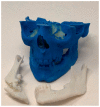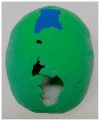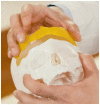Plastic Surgery Innovation with 3D Printing for Craniomaxillofacial Operations
- PMID: 32308239
- PMCID: PMC7144700
Plastic Surgery Innovation with 3D Printing for Craniomaxillofacial Operations
Abstract
Plastic Surgery restores unique human qualities such as appearance, speech (palate), hands, to improve interaction with others and quality of life. Three-dimensional printing technology can be applied to Plastic Surgery craniomaxillofacial operations to change the bony skeleton of the skull, face, and jaws. Three-dimensional printing for patient-specific applications have four types: Type I contour models, Type II guides, Type III splints, Type IV implants. Plastic Surgery innovation in 3D printing clinical applications are described here and https://www.slucare.edu/newsroom/kmov-science-of-healing-faces-of-childhood.php.
Copyright 2020 by the Missouri State Medical Association.
Figures






Similar articles
-
Use of 3-D printing technologies in craniomaxillofacial surgery: a review.Oral Maxillofac Surg. 2018 Sep;22(3):249-259. doi: 10.1007/s10006-018-0704-z. Epub 2018 May 25. Oral Maxillofac Surg. 2018. PMID: 29797107 Review.
-
Virtual Surgical Planning (VSP) in Craniomaxillofacial Reconstruction.Facial Plast Surg Clin North Am. 2022 May;30(2):239-253. doi: 10.1016/j.fsc.2022.01.016. Facial Plast Surg Clin North Am. 2022. PMID: 35501062 Review.
-
The Use of Patient-Specific Implants in Oral and Maxillofacial Surgery.Oral Maxillofac Surg Clin North Am. 2019 Nov;31(4):593-600. doi: 10.1016/j.coms.2019.07.010. Epub 2019 Aug 31. Oral Maxillofac Surg Clin North Am. 2019. PMID: 31481289 Review.
-
How useful is 3D printing in maxillofacial surgery?J Stomatol Oral Maxillofac Surg. 2017 Sep;118(4):206-212. doi: 10.1016/j.jormas.2017.07.002. Epub 2017 Jul 18. J Stomatol Oral Maxillofac Surg. 2017. PMID: 28732777 Review.
-
Clinical applications of three-dimensional printing in otolaryngology-head and neck surgery: A systematic review.Laryngoscope. 2019 Sep;129(9):2045-2052. doi: 10.1002/lary.27831. Epub 2019 Jan 30. Laryngoscope. 2019. PMID: 30698840
Cited by
-
Advances in 3D-Printed Surface-Modified Ca-Si Bioceramic Structures and Their Potential for Bone Tumor Therapy.Materials (Basel). 2021 Jul 9;14(14):3844. doi: 10.3390/ma14143844. Materials (Basel). 2021. PMID: 34300763 Free PMC article. Review.
-
Dental 3D-Printing: Transferring Art from the Laboratories to the Clinics.Polymers (Basel). 2021 Jan 4;13(1):157. doi: 10.3390/polym13010157. Polymers (Basel). 2021. PMID: 33406617 Free PMC article. Review.
-
Digital Surgical Guides in Mandibular Genioplasty: Evaluating Precision Against Conventional Techniques.Aesthetic Plast Surg. 2024 Oct;48(19):3741-3750. doi: 10.1007/s00266-024-04225-5. Epub 2024 Aug 12. Aesthetic Plast Surg. 2024. PMID: 39134680
-
3D printing in oral and maxillofacial surgery: a nationwide survey among university and non-university hospitals and private practices in Germany.Clin Oral Investig. 2022 Jan;26(1):911-919. doi: 10.1007/s00784-021-04073-6. Epub 2021 Jul 19. Clin Oral Investig. 2022. PMID: 34278522
-
Treatment of Facial Asymmetry Caused by Parry-Romberg Syndrome Using Fat Transfer.Cureus. 2025 Mar 21;17(3):e80977. doi: 10.7759/cureus.80977. eCollection 2025 Mar. Cureus. 2025. PMID: 40260330 Free PMC article.
References
-
- Jacobs CA, Lin AY. A New Classification of Three-Dimensional Printing Technologies: Systematic Review of Three-Dimensional Printing for Patient-Specific Craniomaxillofacial Surgery. Plast Reconstr Surg. 2017;139(5):1211–1220. - PubMed
-
- Lin AY, Losee JE. Pediatric Plastic Surgery. In: Zitelli BJ, McIntire SC, Nowalk AJ, editors. Zitelli and Davis’ atlas of pediatric physical diagnosis. 6th ed. Philadelphia, PA: Saunders/Elsevier; 2012.
-
- Danelson KA, Gordon ES, David LR, Stitzel JD. Using a three dimensional model of the pediatric skull for pre-operative planning in the treatment of craniosynostosis - biomed 2009. Biomed Sci Instrum. 2009;45:358–363. - PubMed
-
- Engel M, Hoffmann J, Castrillon-Oberndorfer G, Freudlsperger C. The value of three-dimensional printing modelling for surgical correction of orbital hypertelorism. Oral Maxillofac Surg. 2015;19(1):91–95. - PubMed
-
- Hatamleh MM, Cartmill M, Watson J. Management of extensive frontal cranioplasty defects. J Craniofac Surg. 2013;24(6):2018–2022. - PubMed
Publication types
MeSH terms
LinkOut - more resources
Full Text Sources
